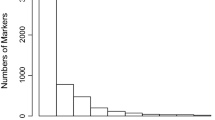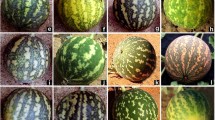Abstract
RAPD (randomly amplified polymorphic DNA) markers generated by arbitary decamers have been successfully employed to detect genetic polymorphisms between coffee species and between Coffea arabica genotypes. The RAPD profiles were used to construct dendrograms and these were consistent with the known history and evolution of Coffea arabica. Material originating from Ethiopia and the arabica sub-groups — C. arabica var. typica and C. arabica var. bourbon — were clearly distinguished. RAPD analysis therefore reflects morphological differences between the sub-groups and the geographical origin of the coffee material. Species-specific amplification products were also identified, but, more importantly, amplification products specific to C. canephora were identified in two C. arabica genotypes, Rume Sudan and Catimor 5175. This diagnostic product is therefore indicative of interspecific gene flow in coffee and has biological implications for selective introgressive hybridisation in coffee. Our study demonstrates the power of the polymerase chain reaction technology for the generation of genetic markers for long-lived perennial tree and bush crops.
Similar content being viewed by others
References
Carlson JE, Tulsieram LK, Glaubitz JC, Luk VWK, Kauffelde C, Ruthedge R (1991) Segregation of random amplified DNA markers in F1 progeny of conifers. Theor Appl Genet 83:194–200
Carvalho A (1952) Taxonima de Coffea arabica L. 6. Caracteres morfologicos dos haploides. Bragantia 12:201–212
Chalmers KJ, Sprent JI, Simons AJ, Waugh R, Powell W (1992) Patterns of genetic diversity in a tropical tree legume (Gliricidia) revealed by RAPD markers. Heredity 69:465–472
Charrier A, Berthaud J (1985) Botanical classification of coffee. In: Clifford MN, Wilson KC (eds) Coffee: botany, biochemistry and production of beans and beverage. Croom Held Ltd Publishers, Beckenham, UK, pp 13–47
Digby PGN, Kempton RA (1987) Multivariate analysis of ecological communities. Chapman and Hall, London
Feinberg AP, Vogelstein B (1984) A technique for radiolabelling DNA restriction endonuclease fragments to high specific activity (Addendum). Anal Biochem 137:266–267
Fritsch P, Reisberg LH (1992) High outcrossing rates maintain male and hermaphrodite individuals in populations of the flowering plant Datisca glomerata. Nature 359:633–636
Gawel NJ, Jarret RL (1991) A modified CTAB DNA extraction procedure for Musa and Ipomoea. Plant Mol Biol Rep 9:262–266
Hadrys H, Balick M, Schierwater B (1992) Applications of random amplified polymorphic DNA (RAPD) in molecular ecology. Mol Ecol 1:35–63
Heun M, Helentjaris T (1993) Inheritance of RAPDs in F1 hybrids of corn. Theor Appl Genet 85:961–968
Hu J, Quiros CF (1991) Identification of broccoli and cauliflower cultivars with RAPD markers. Plant Cell Rep 10:505–554
Kaemmer D, Afza R, Weising K, Kahl G, Novak, FJ (1992) Oligonucleotide and amplification fingerprinting of wild species and cultivars of banana (Musa spp.). Biotechnology 10:1030–1035
Kartha KK, Mroginski LA, Pahl K, Leung NL (1981) Germplasm preservation of coffee (Coffea arabica L.) by in-vitro culture of shoot apical meristems. Plant Sci Lett 22:301–307
Kempton R, McNicol J (1990) Graphical methods for multivariate data. Scottish Agricultural Statistics Service
Klein-Lankhorst R, Rietreld P, Machiels B, Veukeuk R, Weide R, Gebhardt C, Koorneef M, Zabel P (1991) RFLP markers linked to the root knot nematode resistance gene Mi in tomato. Theor Appl Genet 81:661–667
Louarn J (1978) Diversité comparée des descendances de Coffea Arabica obtennes en autofé condation en fécondation libre an Tonkoui 75–78. Orstom, Man, Ivory Coast
Maniatis T, Fritsch EF, Sambrook J (1982) Molecular cloning: a laboratory manual. Cold Spring Harbor Laboratory, Cold Spring Harbor, New York
Nei M, Li W-H (1979) Mathematical model for studying genetical variation in terms of restriction endonucleases. Proc Natl Acad Sci USA 74:5267–5273
Powell W, Phillips MS, McNicol JW, Waugh R (1991) The use of DNA markers to estimate the extent and nature of genetic variability in Solanum tuberosum cultivars. Ann Appl Biol 118:423–432
Rafalski JA, Tingey SV, Williams JGK (1991) RAPD markers — a new technology for genetic mapping and plant breeding. Agbiotech New Inf 3:645–648
Reed KC, Mann DA (1985) Rapid transfer DNA from agarose gels to nylon membranes. Nucleic Acids Res 13:7207–7221
Roy A, Frascaria N, Mackay J, Bousquent J (1992) Segregating random amplified polymorphic DNA (RAPDs) in Betula alleghaniensis. Theor Appl Genet 85:173–180
Russell JR, Hosein F, Johnson E, Waugh R, Powell W (1993) Genetic differentiation of cocoa (Theobroma cacao L.) populations revealed by RAPD analysis. Mol Ecol 2:64–70
Rodrigues CJ Jr, Bettencourt AJ, Rijol L (1975) Races of the pathogen and resistance to coffee rust. Annu Rev Phytopathol 13:49–70
Tanksley SD, Young ND, Pat AH, Bonierbale MW (1989) RFLP mapping in plant breeding — new tools for an old science. Bio/Technology 7:257–264
Thomas AS (1942) The wild arabica coffee of the Boma Plateau Anglo-Egyptian Sudan. Empire J Exp Agric 10:207–212
Vossen HAM van der (1985) Coffee selection and breeding. In: Clifford MN, Wilson KC (eds) Coffee: botany, biochemistry and production of beans and beverage. Crom Held, Beckenham, UK, pp 48–96
Vossen HAM van der, Walyaro DJ (1980). Breeding for resistance to coffee berry disease in Coffea arabica L. II. Inheritance of the resistance. Euphytica 29:777–791
Waugh R, Powell W (1992) Using RAPD markers for crop improvement. Trends Biotechnol 10:186–191
Welsh J, McClelland M (1990) Fingerprinting genomes using PCR with arbitrary primers. Nucleic Acids Res 18:7213–7218
Welsh J, Petersen C, McClelland M (1991) Polymorphisms generated by arbitrarily primed PCR in the mouse: application to strain identification and genetic mapping. Nucleic Acids Res 20:303–306
Wilde J, Waugh R, Powell W (1992) Genetic fingerprinting of Theobroma clones using Randomly Amplified Polymorphic DNA markers. Theor Appl Genet 83:871–877
Williams JGK, Kubelik AR, Livak KJ, Rafalski JA, Tingey SV (1990) DNA polymorphisms amplified by arbitrary primers are useful as genetic markers. Nucleic Acids Res 18:6531–6535
Author information
Authors and Affiliations
Additional information
Communicated by I. Mac Key
On study leave from: Universidad de San Carlos de Guatemala, Facultad de Agronomia, Ciudad Universitaria, Zona 12, Apartado Postal No. 1545, Guatemala, Central America
Rights and permissions
About this article
Cite this article
Orozco-Castillo, C., Chalmers, K.J., Waugh, R. et al. Detection of genetic diversity and selective gene introgression in coffee using RAPD markers. Theoret. Appl. Genetics 87, 934–940 (1994). https://doi.org/10.1007/BF00225787
Received:
Accepted:
Issue Date:
DOI: https://doi.org/10.1007/BF00225787




